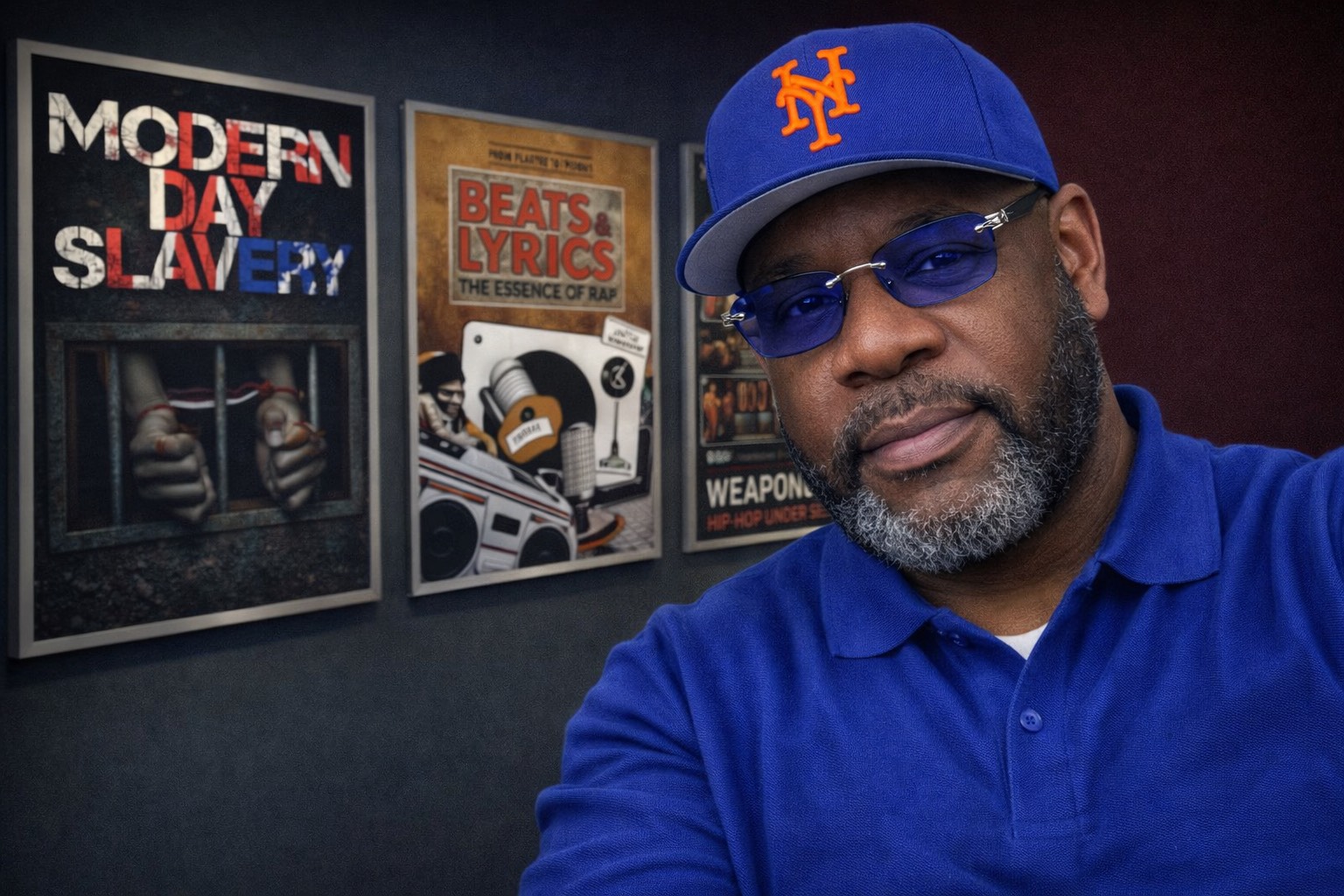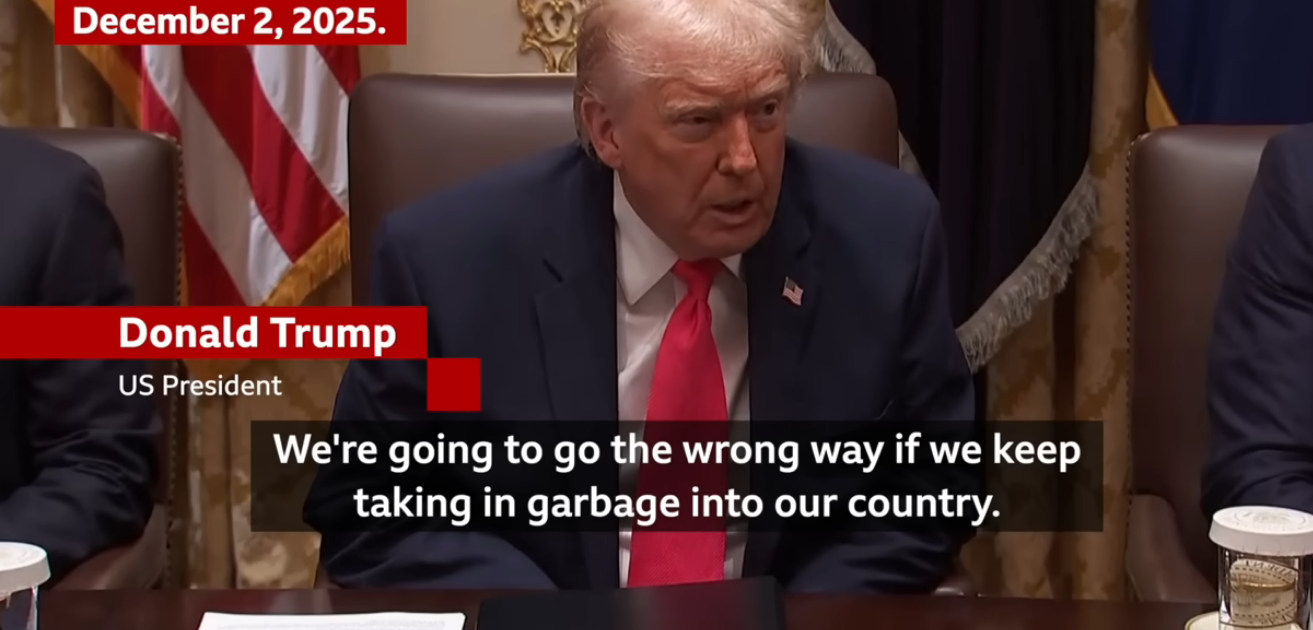Photos: YouTube Screenshots\Wikimedia Commons
Do emotional movie scenes motivate tears?
Has the slow but methodical increase in mass shootings of Black Americans over the last few years numbed you to recent such occurrences? Are these murders no longer repugnant?
Without any intent to incriminate, while you and your partner’s decision to abort undoubtedly concerned your personal futures, was the decision devoid of concerns about Black America’s future?
A tendency to well-up during movies, the near disregard for Black murder due to desensitization, and an absence of concern about Black America’s future are related directly to the media’s power to incite behavior, shape attitudes, and align us with strategies already being implemented as part of America’s socioeconomic plan.
Although seemingly unrelated, the foregoing outcomes are linked to stereotypes.
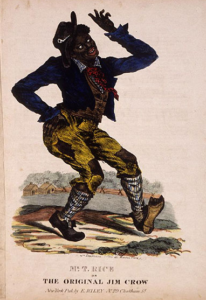
For example, it may not be so disturbing if our tears come during a movie involving Black Americans. However, if we shed tears (of sadness or joy) involving non-Blacks against whom we are competing for survival in America, then we should ask whether those tears express the sentiment that “we are comfortable with our lives in America” (the so-called “happy Negro stereotype”).
Do we mumble under our breadth “there we go again” when we learn about another mass murder and keep on pushing? Does not the “there we go again” thought symbolize our acceptance of the stereotype, “Blacks are more brutish and violent than non-Blacks and are prone to kill each other?”[1]
Finally, and without any intent to be judgmental, we concur that all should have a “right to choose” concerning their bodies. However, it seems disingenuous to claim to be “Black First” and to abort a Black child—except in extenuating circumstances. “Unwanted pregnancies,” and related abortions align closely with the “Blacks are over sexed” stereotype.
Realities of Racist Stereotypes
Racist stereotypes have come to pervade media. In his An American Dilemma: The Negro Problem and Modern Democracy, Gunnar Myrdal was an early assessor of these stereotypes.[2] Comprehensive treatment of Black American stereotypes in media appears in Donald Bogles’ 1989 book, Toms, Coons, Mulattoes, Mammies, and Bucks: An Interpretive History of Blacks in American Films.[3] However, probably the most transparent scholarship concerning the impact of adverse racial stereotypes in media is by Camile Cosby in her 1994 doctoral dissertation, Television’s Imageable Influences: The Self Perceptions of Young African-Americans.[4]
Dr. Cosby research has fundamental economic implications. She states:
The practices of media distortion may affect the self-esteem of young African-Americans in negative ways. Self-image and self-esteem relate to perceptions of one’s group (Norton 1983).[5] If one has a low level of self-esteem, then one will not likely succeed; one will not likely self-actualize or self-affirm. Hence, one may not become self-empowered.
There has been a systematic exclusion of positive images of African-Americans in mainstream art, radio,school textbooks, newspapers, history books, magazines, television, movies, videos, and other forms of media. If African-Americans do not self-define, then they are being described too often by “others” through “others” perceptions. Being described only by “others” can be ubiquitously destructive for African-Americans or any people.[6]
In other words, Black Americans, who consume media that is filled to overflowing with overt and subliminal racist stereotypes, learn to accept second-class citizenship that is reflected in our socioeconomic position. Can you not imagine outcomes if each Black American would come to sanity and refuse to countenance racial discrimination—caused by racist stereotypes—in any form? If Black America acted forcefully to eliminate racial discrimination, then we would certainly experience much different outcomes than those being experienced today.
We agree that racist stereotypes of Black Americans are harmful to us because they influence the behavior of non-Blacks. However, we believe that the most severe harm inflicted by racist stereotypes in media occurs when Black Americans inculcate and reflect racist stereotypical behavior. Figure 1 is a flow diagram that highlight the pathways by which we believe both non-Blacks and
Blacks are affected by racist stereotypes in media.
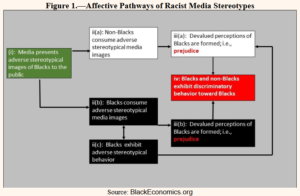
The “adverse racial stereotype” concept, particularly in media, is widely comprehended—including in US courts.[7] Importantly, there appears to be a consensus that racist media stereotypes can be, and are, harmful. These sentiments are expressed even in the June 2023 US Supreme Court decision concerning Affirmative Action in student admissions at Harvard University and the University of North Carolina.[8]
The supreme question is whether US courts will ever deem that “the right to petition the government to halt multifaced and egregious injuries inflicted by racist media stereotypes” is an inalienable right of Black Americans and that it supersedes “free speech rights” because action on the former stands to produce a greater good for America? Note that a July 2023 court ruling unrelated to stereotypes (an injunction against the US Government to discontinue pressuring social media companies) provides robust protection of the “free speech right.”[9]

Addressing Media Stereotypes
Recently, BlackEconomics.org produced two “open letters” on the need for action on racist stereotypes in media.10 Because media owners benefit from racist stereotypes (claiming that they only provide content that is in the “public’s interest”), and because Black Americans are not yet motivated to fast from a steady diet of such stereotypes, a logical course of action to effect change is through pressure on the Federal Communications Commission (FCC).
Although conditions are much more complicated today, a 1977 US Commission on Civil Rights report, Window Dressing on the Set: Women and Minorities in Television, discusses the classic approach for addressing the issue.11 The report highlights how citizens and the courts prompted the FCC to use its regulatory powers to reduce certain racially discriminatory media practices by its
licensees during the 1960s: Namely, to increase Black images in television. The landmark case is “Communication Department of the United Church of Christ vs. F.C.C., 425 F.2d 543. More Black
Americans were incorporated into the media, but they proliferated racist media stereotypes.
To address racist media stereotypes, Black Americans should consider selecting the FCC as a target that may lead to a court decision(s) to halt these stereotypes. To the extent that television still captures a significant media consuming audience, we should plan to achieve the following outcomes:[12]
• Motivate concerned Black American individuals and groups to use a methodological template that can be developed to challenge FCC licensees in their areas of influence to purge racist stereotypes from their broadcasts.[13]
• Identify Black American investors who can acquire broadcast licenses if any are vacated due to a failure to comply with FCC or court rulings requiring the purging of racist media stereotypes.
• Motivate all Black Americans, who are associated with the development of media, to reject projects that include racist media stereotypes.
• Motivate Black leadership at all levels and organizations to convey a “no tolerance” message on adverse media stereotypes in their communications with Black and non-Black audiences.
• Promote education about, and fasts from, the media among Black Americans.
These are fundamental actions that can help halt the injury inflicted by racist media stereotypes. As we perform these actions, we should come to know more completely about the egregious harm that is caused by these stereotypes—to us and against us. It is only when we capture this knowledge that we will become fully vested in the effort to halt racist media stereotypes. To prepare for the work and long road ahead, we should recognize that adverse effects and outcomes that area associated with racist stereotypes are cumulative—reflecting hundreds of years of reinforcement. Therefore, favorable effects and outcomes associated with eliminating racist stereotypes will only be realized fully in the distant future.
Nevertheless, it is imperative that we act now to halt these racist stereotypes to forge that more favorable future!
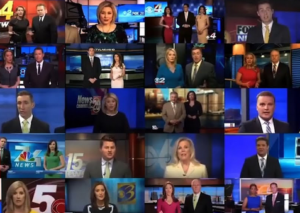
Dr. Brooks Robinson is the founder of the BlackEconomics.org website.
References:
[1] See N. Priest et al (2018), “Stereotyping across intersections of race and age: Racial stereotyping among White adults working with children,” PLoS ONE, Vol. 13, No. 9; https://journals.plos.or/plosone/article?id=10.1371/ournal.pone.0205614 (Ret. 070623). The article reveals that Black adults and teens are more than twice as likely to be rated by White adults with children as violent prone compared to their White peers.
[2] Gunnar Myrdal (1944), An American Dilemma: The Negro Problem and Modern Democracy, New York: Harper & Brothers.
[3] Donald Bogles (1989), Toms, Coons, Mulattoes, Mammies, and Bucks: An Interpretive History of Blacks in American Films, New York: Continuum.
[4 ]Camille Cosby (1994), Television’s Imageable Influences: The Self-Perception of Young African-Americans, Lanham: University Press of America.
[5] The Norton reference is to D. Norton (1983), “Black family life patterns, the development of self, and cognitive development of Black children.” In G. Johnson Powell (Ed.), The Psychosocial development of Minority Group Children, Boston: Houghton Mifflin.
[6]Op. cit. (Camille Cosby 1994). p. 2.
[7] A general search of the digital Thomson Reuters Westlaw Database using the string “media and racial stereotypes and regulation” yielded 21 cases going back to the 1980s. Only four of the 21 cases involved media enterprises. However, none of the cases concerned direct efforts to halt the promulgation of racist stereotypes.
[8] A syllabus of the case is provided at https://www.supremecourt.gov/opinions/22pdf/20-1199_hgdj.pdf (Ret. 070623).
[9] Jim Salter (2023), “Judge limits Biden administration in working with social media companies,” Associated Press, July 4, 2023; https://apnews.com/article/social-media-protected-speech lawsuit-injunction-148c1cd43f88a0284d5a3c53fd333727 (Ret. 070723).
[10] See B. Robinson (2023), “Open Letter to HBCU Law School Deans: Reparations for Black American Defamation” (March 10); and Lindsey Robinson and Brooks Robinson (2023), “Open Letter to Black Americans Concerning the Media” (June 9). BlackEconomics.org.
[11] US Commission on Civil Rights (1977), Window Dressing on the Set: Women and Minorities in Television, Washington, DC. August.
[12] US Department of Labor, Bureau of Labor Statistics (2023), “Table 11A. Time Spent in leisure and sports activities for the civilian population by selected characteristics, averages per day, 2022
annual averages,” American Time Use Survey; https://www.bls.gov/news.release/atus.t11A.htm (Ret. 070723). The table indicates that the US civilian population, on average, spent about 3 hours
per day in 2022 watching television (men – 3.06 hours; women – 2.53 hours). Television viewing remains a very important pass-time.
[13] Black Economics.org plans to help develop this methodological template, including a compendium of scholarly literature that follows Bogles’ (1989) and Cosby’s (1994) work and that emphasizes the injury inflicted by adverse stereotypical media images. The template would also include analyses that confront the presumed right to seek a halt to injuries caused by racist media stereotypes versus other so-called First Amendment Rights



